Simulating Co-Evolution and Knowledge Transfer in Logistic Clusters Using a Multi-Agent-Based Approach
Abstract
:1. Introduction
2. Background
2.1. Simulating Transport Outsourcing
2.2. Outsourcing and Knowledge Transfer
3. Materials and Methods
3.1. Density-Based Spatial Clustering
3.2. Simulation of TOCs Coupling ABM and GIS
3.3. Centrality of Agents
3.4. Simulating Spatial Difussion of Knowledge
3.4.1. Direct Interactions
3.4.2. Indirect Interactions
- All agents can transmit and receive information;
- Agents incorporate the received information as new knowledge;
- The transmitted information is considered valuable;
- The diffusion of information does not take into account physical barriers.
3.4.3. Identifying Environments with High Potential for Knowledge Generation
4. Case Study: The DABB Area
5. Results
5.1. Spatial Clustering
5.2. TOC Simulation
5.2.1. Temporal Distribution of Hiring
5.2.2. Evolving Towards Complexity
5.2.3. Interaction Within and Between Clusters
5.2.4. Knowledge Transfer
6. Discussion
- Logistics clusters. Due to their composition, these clusters constitute the heart of the polarised system, where both logistics and warehouse operators and transport companies dominate the transport activity, thanks to the leadership they exercise over the other environments. The clusters that fit into this classification are the environments of Zaisa and Lanbarren.
- Mixed environments. We can find other environments very close to the logistics clusters where transport is not the dominant activity, although the presence of companies is significant. The transport environments of Ventas and the Port of Pasaia represent this kind of intermediate case.
- Subordinate zones. These groupings are in urban areas in contact with other types of activity and constitute important sites of providers for the logistics clusters. Two zones that perfectly fit under this description are the environments of Irun and Errenteria.
- Peripheral zones. These are small groups of agents that provide their services for the main areas of activity. Their composition, primarily based on the presence of CA, means they are highly dependent on central environments. Examples of this category include the environments of Andoain, Lasarte, and Sorabilla.
- Isolated active environments. No defined groupings or clusters are located there. However, the capacity to generate and transfer knowledge is due to the presence of very active FF and TC agents that offer alternatives to the leadership of the logistics clusters.
7. Conclusions
Supplementary Materials
Author Contributions
Funding
Data Availability Statement
Acknowledgments
Conflicts of Interest
References
- Batty, M.; Crooks, A.T.; See, L.M.; Heppenstall, A.J. Perspectives on Agent-Based Models and Geographical Systems. In Agent-Based Models of Geographical Systems; Springer: Dordrecht, The Netherlands, 2012; pp. 1–15. [Google Scholar] [CrossRef]
- Popovici, E.; Bucci, A.; Wiegand, R.P.; De Jong, E.D. Coevolutionary Principles. In Handbook of Natural Computing; Springer: Berlin/Heidelberg, Germany, 2012; pp. 987–1033. [Google Scholar] [CrossRef]
- Davidsson, P.; Holmgren, J.; Persson, J.A.; Ramstedt, L. Multi Agent Based Simulation of Transport Chains. In Proceedings of the Seventh International Joint Conference on Autonomous Agents and Multi-Agent Systems, Estoril, Portugal, 12–16 May 2008; Available online: https://www.diva-portal.org/smash/get/diva2:836282/FULLTEXT01.pdf (accessed on 20 November 2024).
- Rinehart, L.M.; Eckert, J.A.; Handfield, R.B.; Page, T.J.; Atkin, T. An Assessment of Supplier—Customer Relationships. J. Bus. Logist. 2004, 25, 25–62. [Google Scholar] [CrossRef]
- Joong-Kun Cho, J.; Ozment, J.; Sink, H. Logistics Capability, Logistics Outsourcing and Firm Performance in an E-commerce Market. Int. J. Phys. Distrib. Logist. Manag. 2008, 38, 336–359. [Google Scholar] [CrossRef]
- Daugherty, P.J.; Chen, H.; Ferrin, B.G. Organizational Structure and Logistics Service Innovation. Int. J. Logist. Manag. 2011, 22, 26–51. [Google Scholar] [CrossRef]
- Brekalo, L.; Albers, S. Effective Logistics Alliance Design and Management. Int. J. Phys. Distrib. Logist. Manag. 2016, 46, 212–240. [Google Scholar] [CrossRef]
- Cruijssen, F.; Dullaert, W.; Fleuren, H. Horizontal Cooperation in Transport and Logistics: A Literature Review. Transp. J. 2007, 46, 22–39. [Google Scholar] [CrossRef]
- Daugherty, P.J. Review of Logistics and Supply Chain Relationship Literature and Suggested Research Agenda. Int. J. Phys. Distrib. Logist. Manag. 2011, 41, 16–31. [Google Scholar] [CrossRef]
- Akbari, M. Logistics Outsourcing: A Structured Literature Review. Benchmarking Int. J. 2018, 25, 1548–1580. [Google Scholar] [CrossRef]
- Démare, T.; Bertelle, C.; Dutot, A.; Lévêque, L. Modeling Logistic Systems with an Agent-Based Model and Dynamic Graphs. J. Transp. Geogr. 2017, 62, 51–65. [Google Scholar] [CrossRef]
- Coccia, M. Spatial Mobility of Knowledge Transfer and Absorptive Capacity: Analysis and Measurement of the Impact within the Geoeconomic Space. J. Technol. Transf. 2008, 33, 105–122. [Google Scholar] [CrossRef]
- Blumenberg, S.; Wagner, H.T.; Beimborn, D. Knowledge Transfer Processes in IT Outsourcing Relationships and Their Impact on Shared Knowledge and Outsourcing Performance. Int. J. Inf. Manag. 2009, 29, 342–352. [Google Scholar] [CrossRef]
- Giuliani, E. The Selective Nature of Knowledge Networks in Clusters: Evidence from the Wine Industry. J. Econ. Geogr. 2007, 7, 139–168. [Google Scholar] [CrossRef]
- Mitton, C.; Adair, C.E.; Mckenzie, E.; Patten, S.B.; Perry, B.W. Knowledge Transfer and Exchange: Review and Synthesis of the Literature. Milbank Q. 2007, 85, 729–768. [Google Scholar] [CrossRef] [PubMed]
- Salas-Peña, A.; García-Palomares, J.C. Simulation of Knowledge Transfer in Complex Networks by Coupling ABM and GIS: A Local Road Freight Transport System as a Case Study. Preprint 2024. [Google Scholar] [CrossRef]
- Beckers, J.; Vanhoof, M.; Verhetsel, A. Returning the Particular: Understanding Hierarchies in the Belgian Logistics System. J. Transp. Geogr. 2019, 76, 315–324. [Google Scholar] [CrossRef]
- Lu, J.; Luo, J.; Tian, L.; Tian, Y. Spatial Patterns and the Evolution of Logistics Service Node Facilities in Large Cities—A Case from Wuhan. ISPRS Int. J. Geoinf. 2024, 13, 82. [Google Scholar] [CrossRef]
- Démare, T.; Bertelle, C.; Dutot, A.; Fournier, D. Adaptive Behavior Modeling in Logistic Systems with Agents and Dynamic Graphs. ACM Trans. Auton. Adapt. Syst. 2019, 13, 1–25. [Google Scholar] [CrossRef]
- Kübler, J.; Barthelmes, L.; Görgülü, M.E.; Kagerbauer, M.; Vortisch, P. Modeling Relations Between Companies and CEP Service Providers in an Agent-Based Demand Model Using Open-Source Data. Procedia Comput. Sci. 2023, 220, 486–494. [Google Scholar] [CrossRef]
- Scott, C.; Lundgren, H.; Thompson, P. Guide to Outsourcing in Supply Chain Management. In Guide to Supply Chain Management; Springer: Cham, Switzerland, 2018; Volume Part F629, pp. 189–202. [Google Scholar] [CrossRef]
- Rinsler, S. Outsourcing: The Result of Global Supply Chains? Glob. Logist. 2010, 10, 164–177. [Google Scholar]
- Jharkharia, S.; Shankar, R. Selection of Logistics Service Provider: An Analytic Network Process (ANP) Approach. Omega 2007, 35, 274–289. [Google Scholar] [CrossRef]
- Barthélemy, J.; Adsit, D. The Seven Deadly Sins of Outsourcing. Acad. Manag. Exec. 2003, 17, 87–100. [Google Scholar] [CrossRef]
- Eurostat. Road Freight Transport Measurement (Road Go): Summary of Annual Road Freight Transport by Type of Operation and Type of Transport [road_go_ta_tott]; The statistical office of the European Union: Luxembourg.
- Roorda, M.J.; Cavalcante, R.; McCabe, S.; Kwan, H. A Conceptual Framework for Agent-Based Modelling of Logistics Services. Transp. Res. E Logist. Transp. Rev. 2010, 46, 18–31. [Google Scholar] [CrossRef]
- Wooldridge, M.; Jennings, N.R. Intelligent Agents: Theory and Practice. Knowl. Eng. Rev. 1995, 10, 115–152. [Google Scholar] [CrossRef]
- Ramstedt, L.; Woxenius, J. Modelling Approaches to Operational Decision-Making in Freight Transport Chains. In Proceedings of the 18th NOFOMA Conference, Oslo, Norway, 8–9 June 2006. [Google Scholar]
- Baindur, D.; Viegas, J.M. An Agent Based Model Concept for Assessing Modal Share in Inter-Regional Freight Transport Markets. J. Transp. Geogr. 2011, 19, 1093–1105. [Google Scholar] [CrossRef]
- de Bok, M.; Tavasszy, L. An Empirical Agent-Based Simulation System for Urban Goods Transport (MASS-GT). Procedia Comput. Sci. 2018, 130, 126–133. [Google Scholar] [CrossRef]
- Schröder. Schroeder_allii_2012. Computacional Framework of Multiagente Simulation Freight_transport_activities_submitted_trb(1). Schroeder, S.; Zilske, M.; Liedtke, G.; Nagel, K. Computational Framework for a Multi-Agent Simulation of Freight Transport Activities. In Proceedings of the Transportation Research Board 91st Annual Meeting, Washington DC, USA, 22–26 January 2012; Volume 1, p. 23. [Google Scholar]
- Cavalcante, R.A.; Roorda, M.J. Freight Market Interactions Simulation (FREMIS): An Agent- Based Modeling Framework. In Procedia Computer Science; Elsevier B.V.: Amsterdam, The Netherlands, 2013; Volume 19, pp. 867–873. [Google Scholar] [CrossRef]
- Matteis, T.; Liedtke, G.; Wisetjindawat, W. A Framework for Incorporating Market Interactions in an Agent Based Model for Freight Transport. Transp. Res. Procedia 2016, 12, 925–937. [Google Scholar] [CrossRef]
- Holguín-Veras, J.; Sánchez-Díaz, I. Freight Demand Management and the Potential of Receiver-Led Consolidation Programs. Transp. Res. Part A Policy Pract. 2016, 84, 109–130. [Google Scholar] [CrossRef]
- Taillandier, P.; Vo, D.-A.; Amouroux, E.; Drogoul, A. GAMA: A Simulation Platform That Integrates Geographical Information Data, Agent-Based Modeling and Multi-Scale Control; Springer: Berlin/Heidelberg, Germany, 2012; pp. 242–258. [Google Scholar] [CrossRef]
- Argote, L.; Miron-Spektor, E. Organizational Learning: From Experience to Knowledge. Organ. Sci. 2011, 22, 1123–1137. [Google Scholar] [CrossRef]
- Abdur Razzaque, M.; Chen Sheng, C. Outsourcing of Logistics Functions: A Literature Survey. Int. J. Phys. Distrib. Logist. Manag. 1998, 28, 89–107. [Google Scholar] [CrossRef]
- Tomkins, C. Interdependencies, Trust and Information in Relationships, Alliances and Networks. Account. Organ. Soc. 2001, 26, 161–191. [Google Scholar] [CrossRef]
- Salas, A.; Cases, B.; García Palomares, J.C. Value Chains of Road Freight Transport Operations: An Agent-Based Modelling Proposal. Procedia Comput. Sci. 2019, 151, 769–775. [Google Scholar] [CrossRef]
- Cowan, R. Network Models of Innovation and Knowledge Diffusion. In Clusters, Networks and Innovation; Oxford University Press: New York, NY, USA, 2005; pp. 29–53. [Google Scholar]
- Su, J.; Zhang, X.; Yang, J.; Qian, X. Modelling and Simulating Knowledge Diffusion in Knowledge Collaboration Organisations Using Improved Cellular Automata. J. Simul. 2019, 13, 181–194. [Google Scholar] [CrossRef]
- Tobler, W.R. A Computer Movie Simulating Urban Growth in the Detroit Region. Econ. Geogr. 1970, 46 (Suppl. 1), 234–240. [Google Scholar] [CrossRef]
- Ester, M.; Kriegel, H.-P.; Sander, J.; Xu, X. A Density-Based Algorithm for Discovering Clusters in Large Spatial Databases with Noise. In kdd; AAAI: Philadelphia, PA, USA, 1996; Volume 96, pp. 226–231. [Google Scholar]
- Huang, L.; Yang, Y.; Gao, H.; Zhao, X.; Du, Z. Comparing Community Detection Algorithms in Transport Networks via Points of Interest. IEEE Access 2018, 6, 29729–29738. [Google Scholar] [CrossRef]
- Yang, H.; Le, M. High-Order Community Detection in the Air Transport Industry: A Comparative Analysis among 10 Major International Airlines. Appl. Sci. 2021, 11, 9378. [Google Scholar] [CrossRef]
- Salas-Peña, A.; Cases, B. TRANSOPE: A Multi-Agent Model to Simulate Outsourcing Networks in Road Freight Transport; CoMSES Computational Model Library: Alexandria, VA, USA, 2022. [Google Scholar] [CrossRef]
- Salas-Peña, A.; Cases, B.; García-Palomares, J.C. Complexity in Road Freight Transport Outsourcing Networks. TRANSOPE: An Agent-Based Dynamic Model. Expert. Syst. Appl. 2024, 249, 123699. [Google Scholar] [CrossRef]
- Sheffi, Y.; Saenz, M.J.; Rivera, L.; Gligor, D. New Forms of Partnership: The Role of Logistics Clusters in Facilitating Horizontal Collaboration Mechanisms. Eur. Plan. Stud. 2019, 27, 905–931. [Google Scholar] [CrossRef]
- Brown, D.G.; Riolo, R.; Robinson, D.T.; North, M.; Rand, W. Spatial Process and Data Models: Toward Integration of Agent-Based Models and GIS. J. Geogr. Syst. 2005, 7, 25–47. [Google Scholar] [CrossRef]
- Wilensky, U.; NetLogo. Center for Connected Learning and Computer-Based Modeling: Northwestern University, Evanston, IL. Available online: https://ccl.northwestern.edu/netlogo/ (accessed on 1 February 2020).
- Bavelas, A. Communication Patterns in Task-Oriented Groups. J. Acoust. Soc. Am. 1950, 22, 725–730. [Google Scholar] [CrossRef]
- Newman, M.E.J. The Structure and Function of Complex Networks. SIAM Rev. 2003, 45, 167–256. [Google Scholar] [CrossRef]
- Salas-Peña, A. Encuesta TRANSOPE a Profesionales del Transporte de Mercancías por Carretera de Gipuzkoa; Fundación Guitrans Fundazioa: Donostia-San Sebastián, Spain, 2021. [Google Scholar]
- Anselin, L. Local Indicators of Spatial Association—LISA. Geogr. Anal. 1995, 27, 93–115. [Google Scholar] [CrossRef]
- Bivand, R.S.; Wong, D.W.S. Comparing Implementations of Global and Local Indicators of Spatial Association. Test 2018, 27, 716–748. [Google Scholar] [CrossRef]
- Brunsdon, C.; Comber, L. An Introduction to R for Spatial Analysis and Mapping; SAGE Publications Ltd.: New York, NY, USA, 2018. [Google Scholar]
- Benjamini, Y.; Hochberg, Y. Controlling the False Discovery Rate: A Practical and Powerful Approach to Multiple Testing. J. R. Stat. Soc. Ser. B Stat. Methodol. 1995, 57, 289–300. [Google Scholar] [CrossRef]
- Daniel, W.W. Applied Nonparametric Statistics; Houghton Mifflin: Boston, MA, USA, 1978. [Google Scholar]
- Albert, R.; Barabási, A.-L. Statistical Mechanics of Complex Networks. Rev. Mod. Phys. 2001, 74, 47. [Google Scholar] [CrossRef]
- Opsahl, T.; Agneessens, F.; Skvoretz, J. Node Centrality in Weighted Networks: Generalizing Degree and Shortest Paths. Soc. Netw. 2010, 32, 245–251. [Google Scholar] [CrossRef]
- Csardi, G.; Nepusz, T. The Igraph Software Package for Complex Network Research. Inter. J. Complex. Syst. 2006, 1695, 1–9. [Google Scholar]
- Dong, X.; Castro, L.; Shaikh, N. Fastnet: An r Package for Fast Simulation and Analysis of Large-Scale Social Networks. J. Stat. Softw. 2020, 96, 1–23. [Google Scholar] [CrossRef]
- Freeman, L.C. Centrality in Social Networks Conceptual Clarification. Soc. Netw. 1978, 1, 215–239. [Google Scholar] [CrossRef]
- Sheffi, Y. Logistics-Intensive Clusters: Global Competitiveness and Regional Growth. In International Series in Operations Research and Management Science; Springer: New York, NY, USA, 2013; Volume 181, pp. 463–500. [Google Scholar] [CrossRef]
- Chhetri, P.; Butcher, T.; Corbitt, B. Characterising Spatial Logistics Employment Clusters. Int. J. Phys. Distrib. Logist. Manag. 2014, 44, 221–241. [Google Scholar] [CrossRef]
- Van den Heuvel, F.P.; de Langen, P.W.; van Donselaar, K.H.; Fransoo, J.C. Spatial Concentration and Location Dynamics in Logistics: The Case of a Dutch Province. J. Transp. Geogr. 2013, 28, 39–48. [Google Scholar] [CrossRef]
- Rivera, L.; Sheffi, Y.; Knoppen, D. Logistics Clusters: The Impact of Further Agglomeration, Training and Firm Size on Collaboration and Value Added Services. Int. J. Prod. Econ. 2016, 179, 285–294. [Google Scholar] [CrossRef]
- Beckers, J.; Thomas, I.; Vanoutrive, T.; Verhetsel, A. Logistics Clusters, Including Inter-Firm Relations through Community Detection. EJTIR Issue 2018, 18, 178–195. [Google Scholar] [CrossRef]
- Barabási, A.-L.; Albert, R. Emergence of Scaling in Random Networks. Science 1999, 286, 509–512. [Google Scholar] [CrossRef] [PubMed]
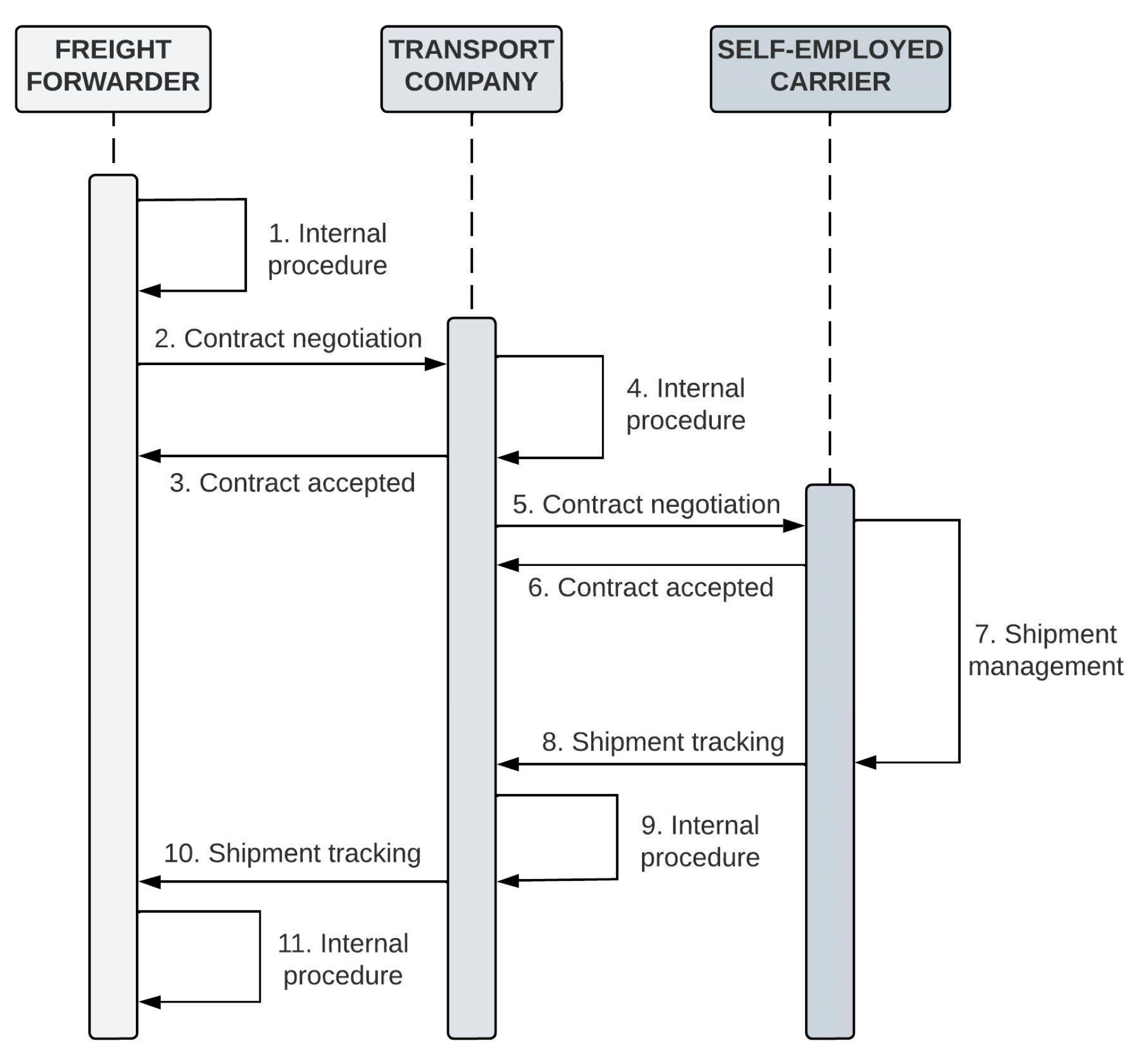
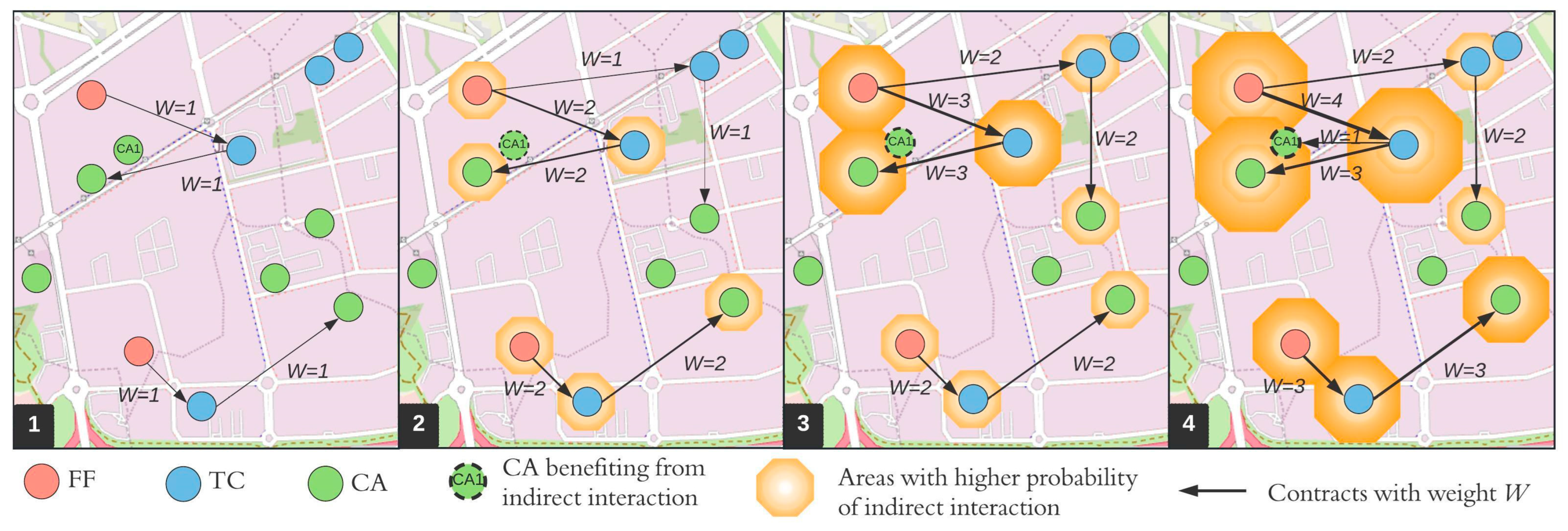


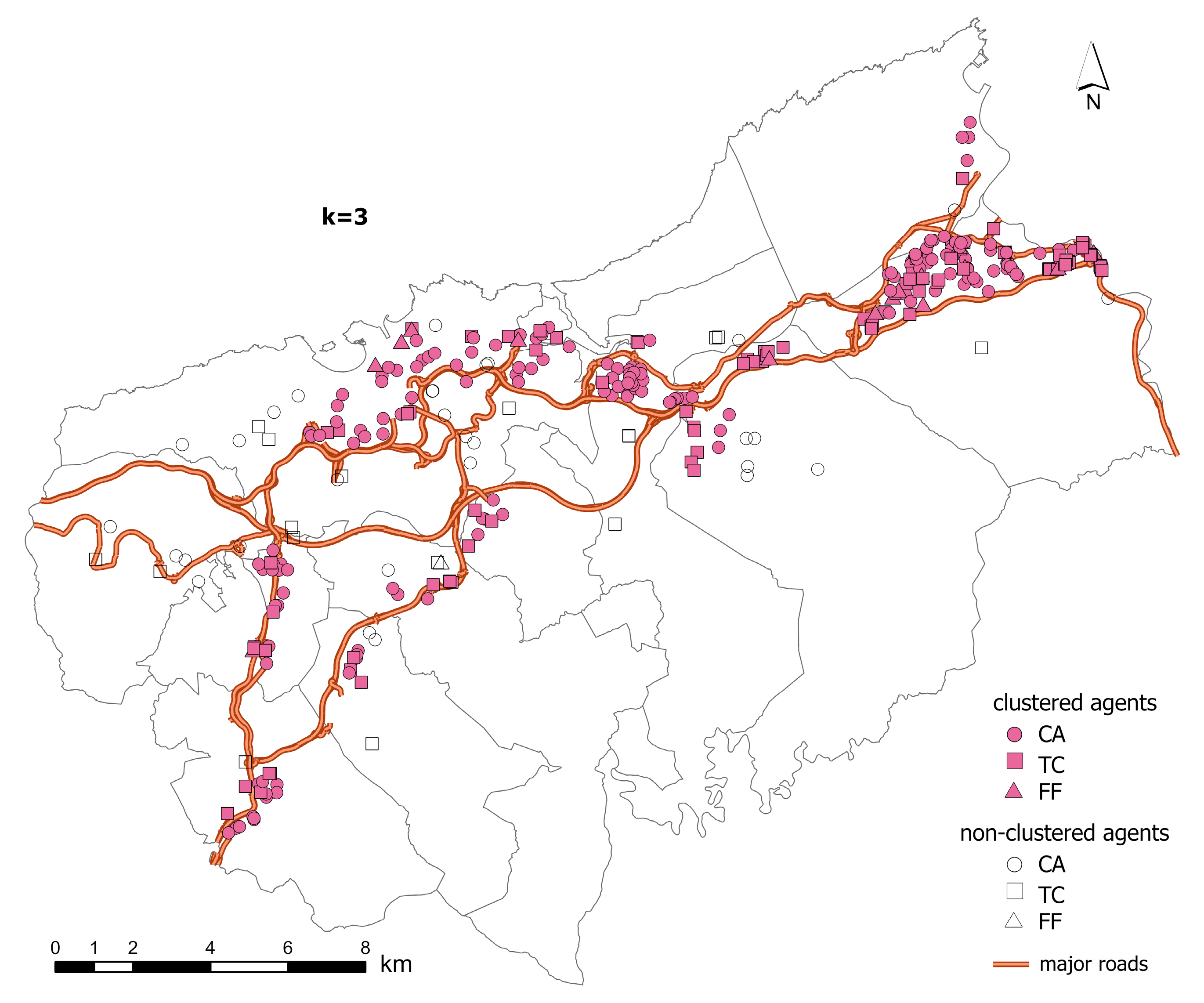




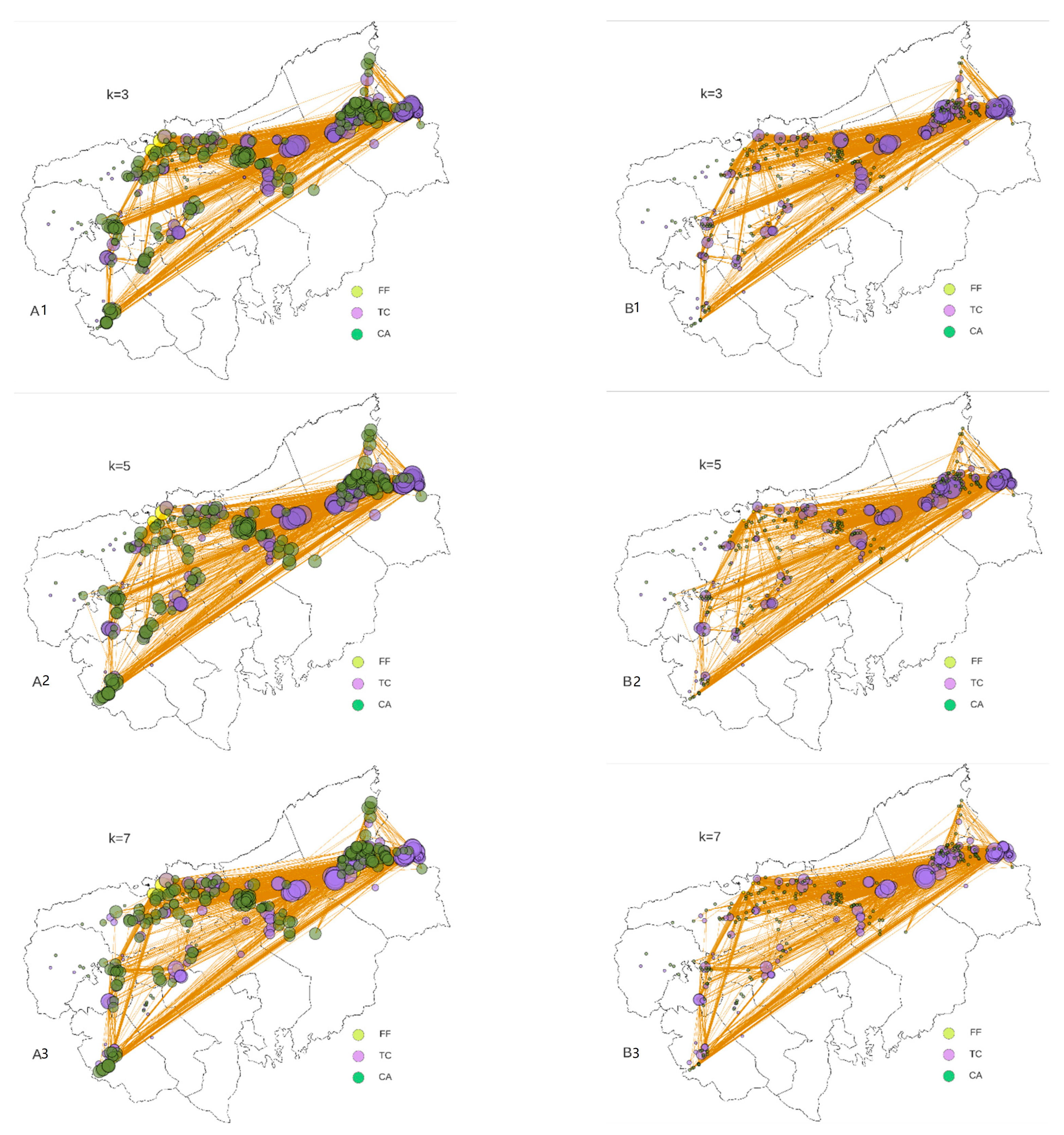

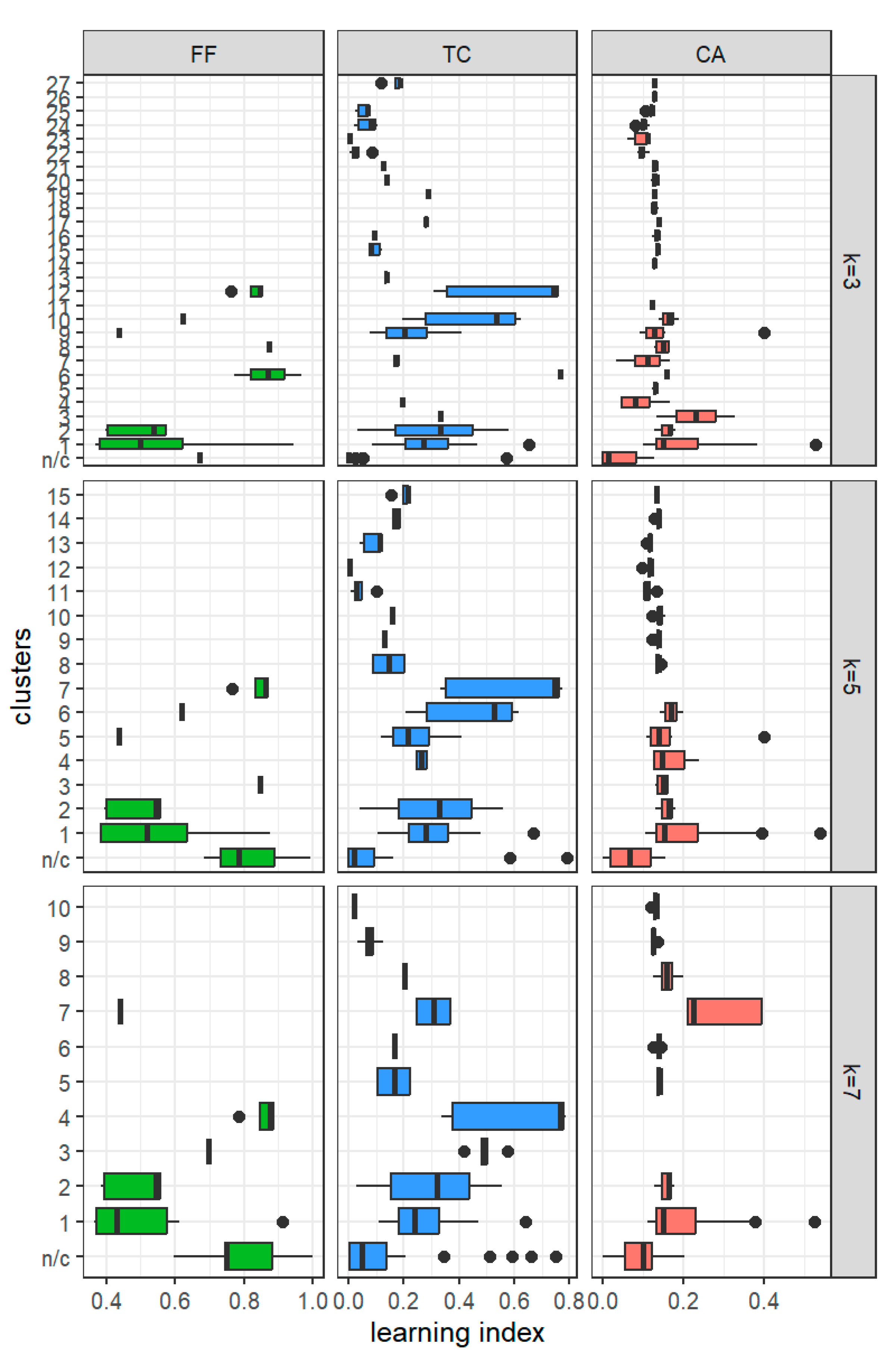
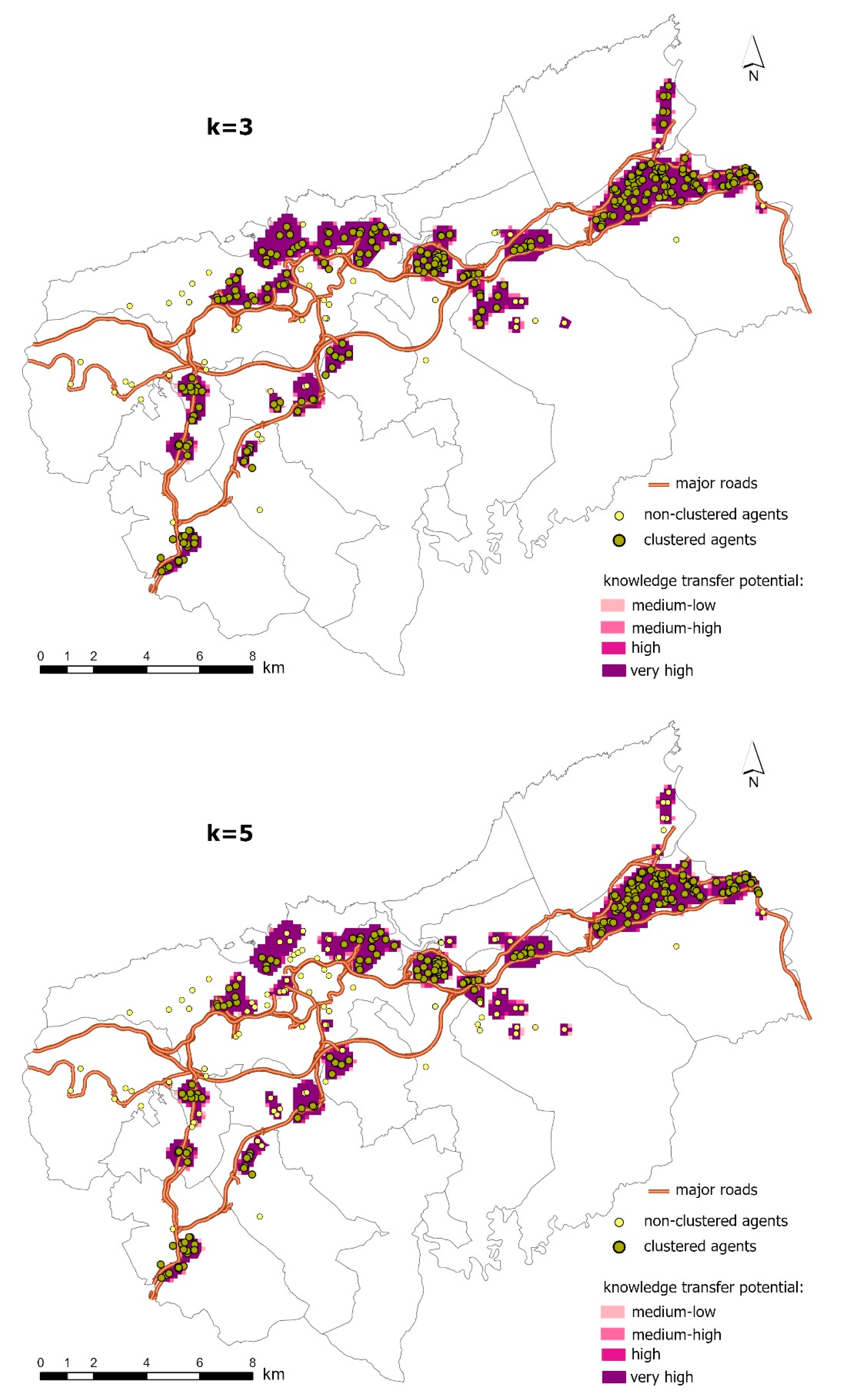
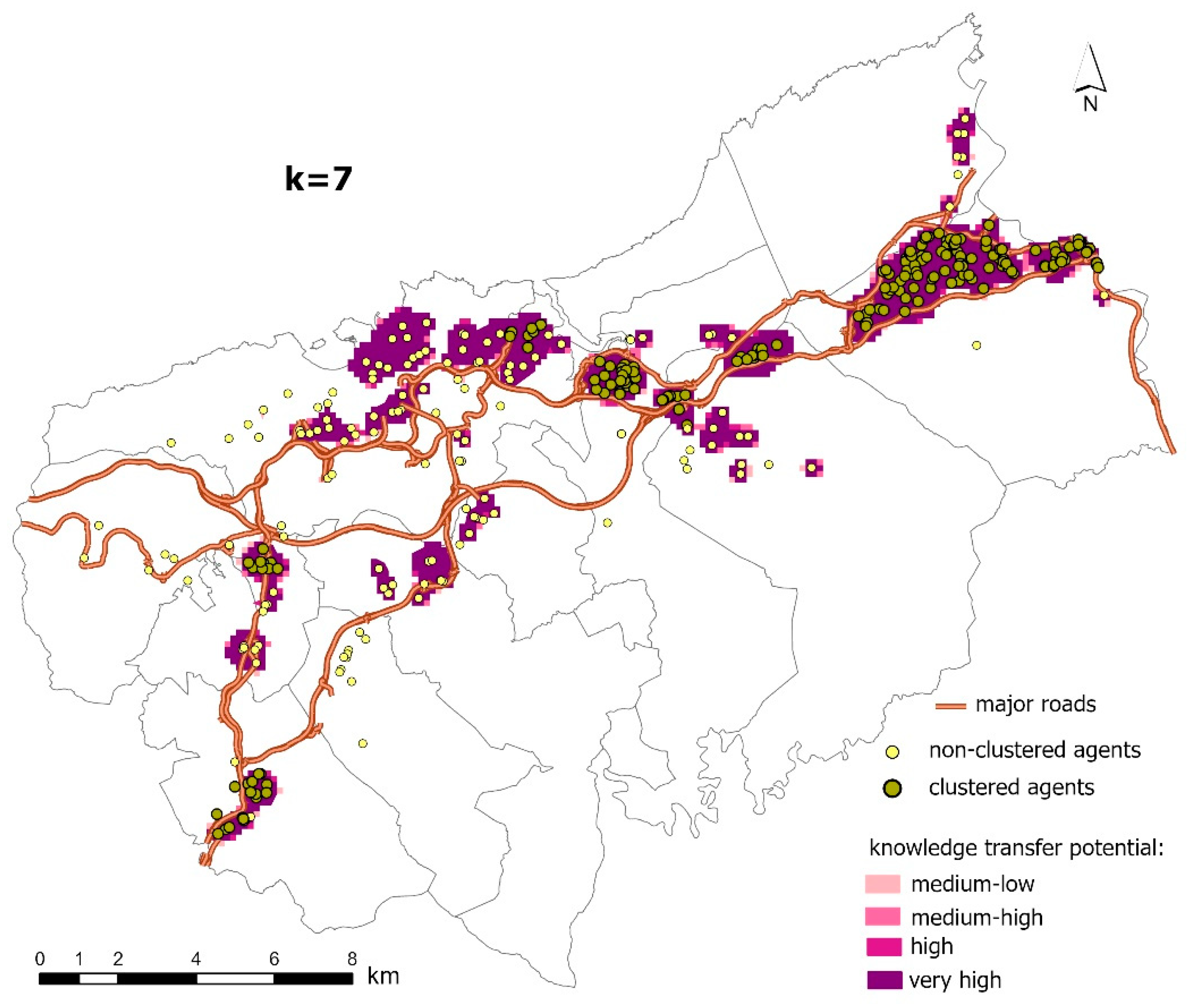
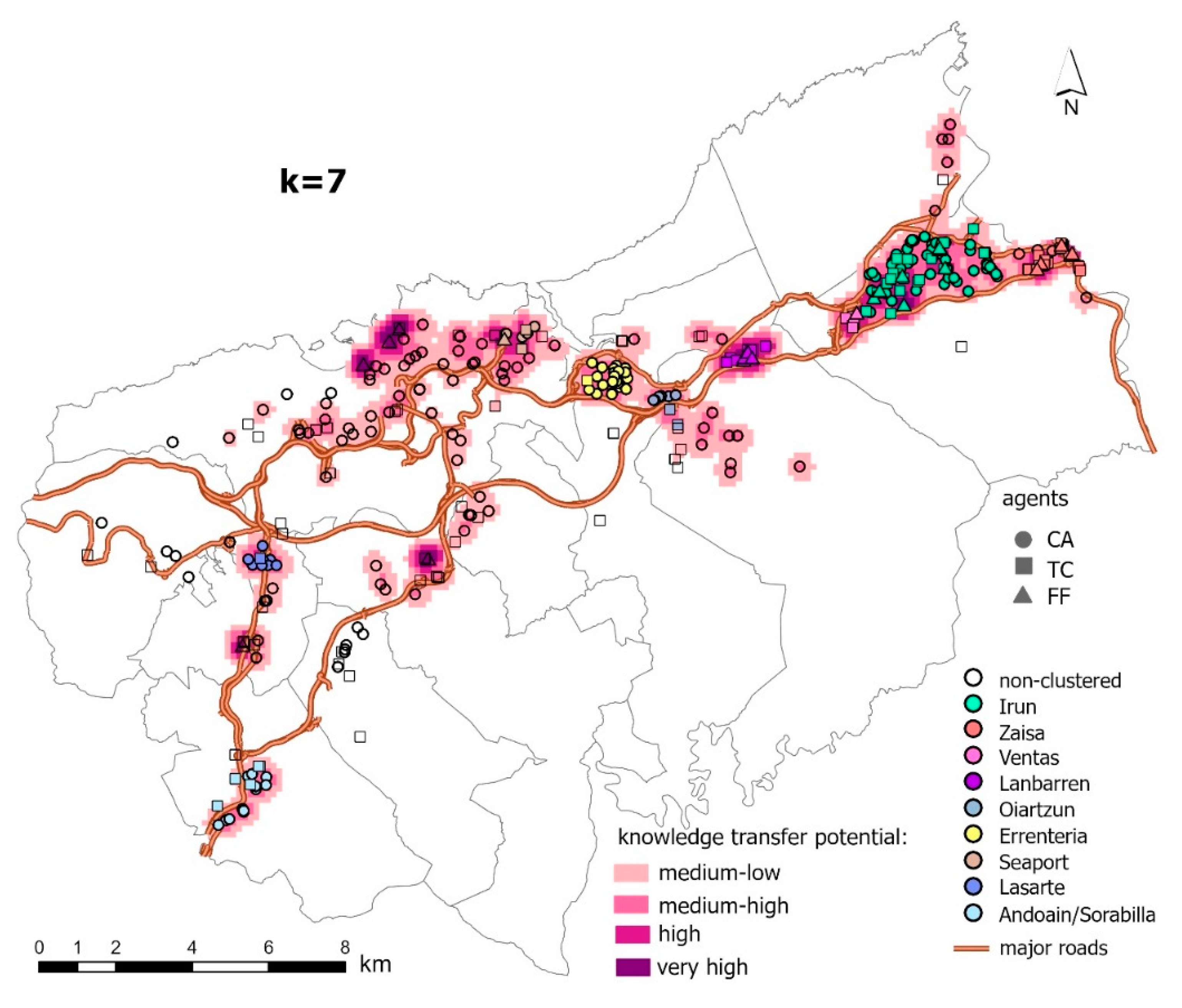
| Competitiveness (C) | Trust (T) | Availability (D) | |
|---|---|---|---|
| F (max C) | 1 | 0.82 | 0.79 |
| F (max T) | 0.78 | 1 | 0.80 |
| F (max D) | 0.82 | 0.86 | 1 |
| Clusters | Clusterised Agents | Non-Clusterised Agents | Biggest Cluster | Smallest Cluster | Mean | Median | |
|---|---|---|---|---|---|---|---|
| k = 3 | 27 | 290 | 48 | 90 | 3 | 12.07 | 6.5 |
| k = 5 | 15 | 244 | 94 | 90 | 5 | 21.13 | 9.5 |
| k = 7 | 10 | 199 | 139 | 84 | 7 | 30.77 | 10 |
| Local Measures | Global Measures | ||||||||
|---|---|---|---|---|---|---|---|---|---|
| Clustered Agents | Non-Clustered Agents | ||||||||
| DC | CC | BC * | DC | CC | BC * | CD | CC | CB | |
| k= 3 | 0.0355 | 0.2621 | 1.949 × 10−4 | 0.0092 | 0.1070 | 1.754× 10−5 | 0.0436 | 0.1161 | 6.463 × 10−4 |
| k= 5 | 0.0379 | 0.2742 | 2.200 × 10−4 | 0.0180 | 0.1836 | 3.977× 10−5 | 0.0421 | 0.1090 | 6.594 × 10−4 |
| k= 7 | 0.0410 | 0.2875 | 2.954 × 10−4 | 0.0219 | 0.2169 | 5.741 × 10−5 | 0.0536 | 0.1540 | 0.0012 |
| Number of Agents | Contracts (μ) | Learning Index (μ) | ||||||||||
|---|---|---|---|---|---|---|---|---|---|---|---|---|
| FF | TC | CA | all | FF | TC | CA | all | FF | TC | CA | All | |
| non-clustered | 5 | 45 | 88 | 139 | 104.15 | 10.45 | 9.68 | 13.33 | 0.79 | 0.11 | 0.09 | 0.12 |
| Irun | 7 | 20 | 52 | 79 | 103.51 | 27.62 | 13.83 | 25.27 | 0.51 | 0.26 | 0.2 | 0.24 |
| Zaisa | 5 | 27 | 3 | 35 | 103.24 | 21.34 | 13.96 | 32.41 | 0.48 | 0.3 | 0.16 | 0.31 |
| Ventas | 1 | 6 | 0 | 7 | 102.93 | 46.08 | - | 55.56 | 0.69 | 0.49 | - | 0.53 |
| Lanbarren | 4 | 7 | 0 | 11 | 104.62 | 47.76 | - | 68.44 | 0.84 | 0.59 | - | 0.68 |
| Oiartzun | 0 | 2 | 7 | 9 | - | 20.6 | 13.92 | 15.41 | - | 0.16 | 0.14 | 0.14 |
| Errenteria | 0 | 1 | 22 | 23 | - | 19.73 | 13.84 | 14.09 | - | 0.17 | 0.29 | 0.14 |
| Puerto | 1 | 2 | 5 | 8 | 102.07 | 42.93 | 13.75 | 32.08 | 0.44 | 0.3 | 0.16 | 0.31 |
| Lasarte | 0 | 1 | 9 | 10 | - | 37.53 | 13.71 | 16.09 | - | 0.2 | 0.13 | 0.16 |
| Andoain | 0 | 4 | 6 | 10 | - | 6.27 | 13.68 | 10.71 | - | 0.07 | 0.13 | 0.1 |
| Sorabilla | 0 | 1 | 7 | 8 | - | 1.53 | 13.79 | 12.26 | - | 0.01 | 0.14 | 0.12 |
Disclaimer/Publisher’s Note: The statements, opinions and data contained in all publications are solely those of the individual author(s) and contributor(s) and not of MDPI and/or the editor(s). MDPI and/or the editor(s) disclaim responsibility for any injury to people or property resulting from any ideas, methods, instructions or products referred to in the content. |
© 2025 by the authors. Published by MDPI on behalf of the International Society for Photogrammetry and Remote Sensing. Licensee MDPI, Basel, Switzerland. This article is an open access article distributed under the terms and conditions of the Creative Commons Attribution (CC BY) license (https://creativecommons.org/licenses/by/4.0/).
Share and Cite
Salas-Peña, A.; García-Palomares, J.C. Simulating Co-Evolution and Knowledge Transfer in Logistic Clusters Using a Multi-Agent-Based Approach. ISPRS Int. J. Geo-Inf. 2025, 14, 179. https://doi.org/10.3390/ijgi14040179
Salas-Peña A, García-Palomares JC. Simulating Co-Evolution and Knowledge Transfer in Logistic Clusters Using a Multi-Agent-Based Approach. ISPRS International Journal of Geo-Information. 2025; 14(4):179. https://doi.org/10.3390/ijgi14040179
Chicago/Turabian StyleSalas-Peña, Aitor, and Juan Carlos García-Palomares. 2025. "Simulating Co-Evolution and Knowledge Transfer in Logistic Clusters Using a Multi-Agent-Based Approach" ISPRS International Journal of Geo-Information 14, no. 4: 179. https://doi.org/10.3390/ijgi14040179
APA StyleSalas-Peña, A., & García-Palomares, J. C. (2025). Simulating Co-Evolution and Knowledge Transfer in Logistic Clusters Using a Multi-Agent-Based Approach. ISPRS International Journal of Geo-Information, 14(4), 179. https://doi.org/10.3390/ijgi14040179








